Manuscript Checklist
- 格式:doc
- 大小:18.00 KB
- 文档页数:2
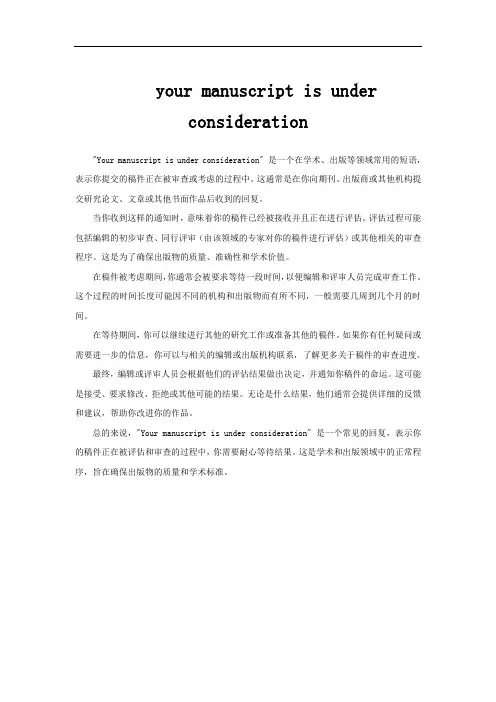
your manuscript is under
consideration
"Your manuscript is under consideration" 是一个在学术、出版等领域常用的短语,表示你提交的稿件正在被审查或考虑的过程中。
这通常是在你向期刊、出版商或其他机构提交研究论文、文章或其他书面作品后收到的回复。
当你收到这样的通知时,意味着你的稿件已经被接收并且正在进行评估。
评估过程可能包括编辑的初步审查、同行评审(由该领域的专家对你的稿件进行评估)或其他相关的审查程序。
这是为了确保出版物的质量、准确性和学术价值。
在稿件被考虑期间,你通常会被要求等待一段时间,以便编辑和评审人员完成审查工作。
这个过程的时间长度可能因不同的机构和出版物而有所不同,一般需要几周到几个月的时间。
在等待期间,你可以继续进行其他的研究工作或准备其他的稿件。
如果你有任何疑问或需要进一步的信息,你可以与相关的编辑或出版机构联系,了解更多关于稿件的审查进度。
最终,编辑或评审人员会根据他们的评估结果做出决定,并通知你稿件的命运。
这可能是接受、要求修改、拒绝或其他可能的结果。
无论是什么结果,他们通常会提供详细的反馈和建议,帮助你改进你的作品。
总的来说,"Your manuscript is under consideration" 是一个常见的回复,表示你的稿件正在被评估和审查的过程中,你需要耐心等待结果。
这是学术和出版领域中的正常程序,旨在确保出版物的质量和学术标准。
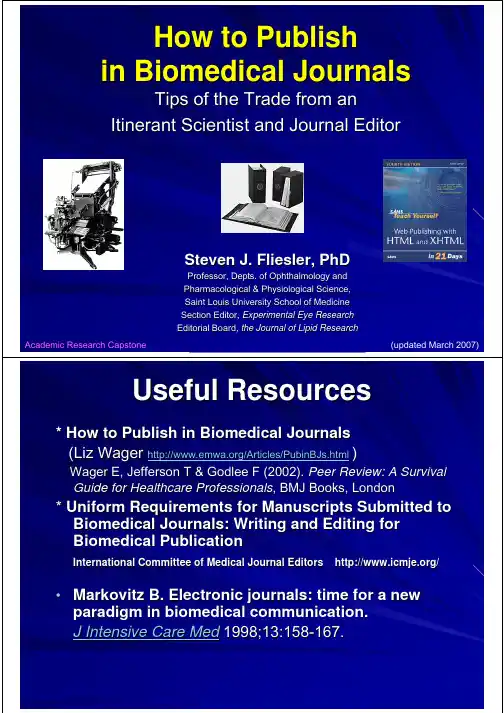
How to Publishin Biomedical JournalsTips of the Trade from anItinerant Scientist and Journal EditorSteven J. Fliesler, PhDProfessor, Depts. of Ophthalmology andPharmacological & Physiological Science,Saint Louis University School of MedicineSection Editor, Experimental Eye ResearchEditorial Board, the Journal of Lipid Research(updated March 2007) Useful Resources* How to Publish in Biomedical Journals(Liz Wager /Articles/PubinBJs.html)Wager E, Jefferson T & Godlee F (2002). Peer Review: A SurvivalGuide for Healthcare Professionals, BMJ Books, London* Uniform Requirements for Manuscripts Submitted to Biomedical Journals: Writing and Editing forBiomedical PublicationInternational Committee of Medical Journal Editors /•Markovitz B. Electronic journals: time for a new paradigm in biomedical communication.J Intensive Care Med1998;13:158-167.First Things FirstChoose the right journal*Consider the implications of your research, your intended audience and the message you want to communicate.Ask colleagues which journals they read and respect; where are most papers in your field published?Browse back-issues to understand the journal's scope. (“who and what”--“Impact Factor”) Check that the format you have chosen is acceptable (e.g., don't send a review to a journal that only publishes original research).Instructions to AuthorsWhen all else fails….READ THE DIRECTIONS!Usually in inside back cover (print version) or on website for journalPoints of journal style (manuscript text layout, subheadings, length, etc.; literature citations; illustration format/restrictions) Specific directions for submitting manuscript (print vs. electronic submission) READ THE DIRECTIONS AGAIN!The Journal of the American Medical Association---To Promote the Science and Art of Medicine and theBetterment of the Public HealthInstructions for AuthorsMANUSCRIPT CRITERIA AND INFORMATION/ifora_current.dtlJAMA is an international, peer-reviewed, general medical journal that is distributed to readers in more than 140 countries and is published in multiple international editions and languages.Manuscript Submission.We encourage authors to submit manuscripts via e-mail. Send manuscripts to the Editor, JAMA,at jamams@. Include a cover letter and complete contact information for the corresponding author: address, telephone and fax numbers, and e-mail address. Tables, figures, and text should be included in the same file if possible.Manuscripts submitted by e-mail should not also be submitted by mail or fax. See Manuscript Checklist and details in these instructions for additional requirements. Editorial office contact information: JAMA, 515 N State St, Chicago, IL 60610, USA; telephone: (312) 464-2402; fax: (312) 464-5824; e-mail:jamams@.Categories of Articles Original full-length articles (previouslyunpublished material)Short communications / case reportsLetters to the Editor / commentaryReview articlesSpecial communications (alerts, etc.) Each journal has its own scope and types of articles accepted for publication, Restrictions to form and style for each, etc.Criteria for Manuscripts(What the Editors look for)Material is original and high-qualityWriting is clear and grammatically correct; style conforms to journal guidelinesStudy methods are appropriateData are valid (reproducible; statistical signif.)Conclusions are supported by the dataInformation is important (impact on field)Topic has general biomedical interest (orspecific interest to the journal’s audience)*Note: some journals have exceedingly stringent acceptance criteria, and only publish a small percentage of articles submitted (e.g., Science, Nature, Cell, etc.) Choosing the Correct Journalfor Your Manuscript Submission“Aim high…but within reason (chances of success)”“JIR targets hypocrisy, arrogance, and ostentatious sesquipedalian circumlocution.We're a friendly escape from the harsh and the hassle.JIR makes you feel good!”Norm SperlingEditorspoofs parodies whimsies burlesques lampoons satires/home.htmlSections/Componentsof ManuscriptAbstract (typically 250-300 words; some may have subheadings: Purpose; Methods; Outcome Measures; Results; Conclusions) IntroductionMaterials and MethodsResultsDiscussion / Conclusions AcknowledgmentsLiterature citedTables; Figure Legends/FiguresFace PageTitle of articleAuthor list / Institutional affiliationsDesignated “corresponding author”contact information (incl. email, phone/fax)Running (short) titleKeywords (*may be separate page)Abbreviations (*may be separate page) Note:some journals discourage headers/footers with author ID info on subsequent ms pages (“blind”review)FiguresGraphs and other line art / illustrations;images (photos / photomicrographs)Publication quality?Conform to journal specifications?Number (too many? too few?)B&W vs. color (necessary? $$$)Labels?*Journal usually specifies to annotate each figure (on back) with fig. no., last name of corresponding author, and indication of preferred orientationIMPORTANT NOTE: Submitted figures (electronic format) may be subject to extraordinary scrutiny, looking for signs of “manipulation”See editorial by Nicholas Wade (New York Times, Jan. 24, 2006): “It May Look Authentic; Here's How to Tell It Isn't”Many leading journals are now instituting this practiceThe New York Times(January 24, 2006)It May Look Authentic; Here's How to Tell It Isn'tBy NICHOLAS WADEAmong the many temptations of the digital age, photo-manipulation has proved particularly troublesome for science, and scientific journals are beginning to respond.Some journal editors are considering adopting a test, in use at TheJournal of Cell Biology, that could have caught the concocted imagesof the human embryonic stem cells made by Dr. Hwang Woo Suk.At The Journal of Cell Biology, the test has revealed extensive manipulation of photos. Since 2002, when the test was put in place,25 percent of all accepted manuscripts have had one or more illustrations that were manipulated in ways that violate the journal's guidelines, said Michael Rossner of Rockefeller University, theexecutive editor. The editor of the journal, Ira Mellman of Yale, said that most cases were resolved when the authors provided originals. "In 1 percent of the cases we find authors have engaged in fraud,"he/2006/01/24/science/24frau.html?ex=1140411600&en=4658d23018bca48a&ei=5070Forms, Forms, Forms Checklist (items specified by journal)Copyright transfer agreement (all authors sign? corresponding author signs on behalf of all coauthors?) In addition to “ownership”:*manuscript is original, and not under consideration for publication elsewhere*all coauthors have reviewed and approved the final version of the manuscript being submittedOther authorizations (e.g., to reproduce material from another copyrighted source)Assurances (formal statement regarding ethical treatment of animals and/or human subjects used in research)Cover Letter: Be ProfessionalUse official letterhead (verifies where you work). Get the editor's name right! (misspelling editor’s name or sending a letter addressed to previous editor does not inspire confidence).Describe SUCCINCTLY what you found and why this will interest the readers of the journal; what is key message / implications of your findings?WHY are you submitting to THIS particular journal? Show an understanding of the journal's readership and/or previous related publications.Consult the Instructions to Authors for necessary wording (e.g., that the paper is not being considered for publication by other journals; etc.) Can recommend/exclude referees!Now that it’s submitted…. Journals usually acknowledge receipt of submissions (typically by email)Usually assign a reference number for all further correspondence.Once you have received this acknowledgement, ALL YOU CAN DO IS WAIT!Some journals (notably the pay journals and electronic ones) aim to make a decision in a couple of weeks. For the rest, decision-making usually takes from 2 to 6 months.The Big Clock(1948)Stages of the Process* Editorial office receives manuscriptEditor (or Section Editor) assigns it to an Editorial Board Member (EBM)EBM sends it to referees for review (usually with time limit, e.g,. 2 wks) Referees file review report; EBM makes recommendation to Editor/Section Editor Editor/Section Editor informs authors of decision* Different journals may vary in the exact stages and means usedPossible OutcomesOutright rejection (gee, that was quick!) Rejection with an invitation to make major changes and resubmit (usually re-reviewed by same referees as original)Conditional acceptance (pending minor revisions in response to referees’comments)Acceptance (unconditional; no revisions)“Yeah, baby, YEAH!”Manuscript rejected?DON’T JUMP OFF A BRIDGE! Read the referees' or Editor's comments carefully after the initial disappointment has worn off.Put away the reviews for a couple of days, then read them again and decide, with your co-authors, whether or not to change the paper.Re-submitting to the same journal is not usually worthwhile. However, if you feel the critiques are completely flawed, or you are able to answer the major criticisms, it may be worth appealing the decision to the Editor. (In most cases, though, it is better to submit elsewhere.)“Conditional”Acceptance? Conditional on the authors responding suitably to the referees' comments.NOTE: Usually, you DO NOT have to make ALL the changes indicated by the referees (unless explicitly told to do so by the Editor), but you do have to adequately address all their concerns.If you are unwilling to change something, you can REBUT the criticisms, but must give compelling arguments.Prepare a detailed letter of response describing EXACTLY what changes have been made to the original manuscript. If reviewers number their comments, use their numbering system for your response.“Conditional”Acceptance?If you find errors overlooked by the referees or you feel inspired to make changes not suggested by the reviewers, you should identify these in the cover letter. (In most cases, Editors are happy to accept these, since it is easier to make changes at this stage than after typesetting. )Some journals return revised papers to the original referees; alternatively, the Editor may decide directly whether to accept the revised manuscript. Editors also may send your paper to another reviewer, e.g., a statistician. Regardless, you will get a response to your revised paper.In some cases, the Editor will request that you make further changes. The same rules apply.Once the paper is accepted:You will receive formal notification ofacceptance (email; letter).RETAIN THIS NOTIFICATION as proof of acceptance. (e.g., In case you want to cite your work elsewhere before it is published, you may need to provide evidence that your manuscript is "in press“).Some journals now immediately posting the manuscript version to their web sites (“E-Published ahead of print”) Another good reasonto make sure everything is 100% correct in thefinal version submitted to the journal.After the dust settles….You will receive “page proofs”of your manuscript from the publisher.Before it is typeset, it will undergo technical editing. (sub-editors are experts in preparing papers for printing, good at picking up errors/inconsistencies, and putting paper into that journal’s style.Journals usually expect a rapid response to proofs (24-48 hours, faxed, emailed, or both). Make sure Editor is informed, re: changes to corresponding author's contact info.Normally, ALL CHANGES are marked directly on the proofs; it also is a good idea to provide a cover letter, reiterating the corrections.Sit back, relax…. or start your next paper!Electronic (Web-Based) Journals http://www.health.library.mcgill.ca/ejournal/intro.htm#e-journals Electronic Biomedical PublishingBioMed Central (BMC)-the new barrier-free NIHrepository for peer-reviewed primary research reports in the life sciences. Through a series of newly created BMC journals, now indexed in PubMed, the site publishesresearch articles in all areas of biomedical research with full peer review.PubMed Central-developed by the National Center for Biotechnology Information (NCBI), PubMed Central is an open access archive of journal literature for all of the life sciences.NetPrints: Clinical Medicine and Health Research-acollaboration between the BMJ Publishing Group andStanford University Library's HighWire Press, NetPrints is another web-based repository for "preprints". Thephilosophy underlying the site is set out in an article in theof the British Medical Journal. Electronic Publishing ResourcesBibliography of Canadian Medical Periodicals-compiled by David CrawfordBiomedical Journal Title Search, converts abbreviated journal titles into full titles or vice versa. Ohio State UniversityBiomedical Publishers, provides an alphabetical listing of biomedical publishers. Vanderbilt UniversityCitation Style Guides for Internet and Electronic Sources. Provides examples of how to cite different electronic resources inbibliographies. University of Alberta Libraries.Citing Datafiles& Internet Sources-McIntyre Library, University of Wisconsin Eau-ClaireElectronic Reference Formats-American Psychological Association Instructions to Authors in the Health Sciences-provides instructions for over 2,000 journals in the health sciences. Medical College ofOhioNational Library of Medicine Recommended Formats forBibliographic Citation. Supplement: Internet Formats. July 2001One day you wake up, and you realize….…you’re one of the few, the proud, the PUBLISHED!。
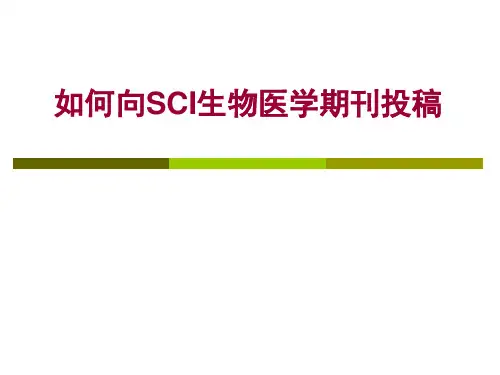
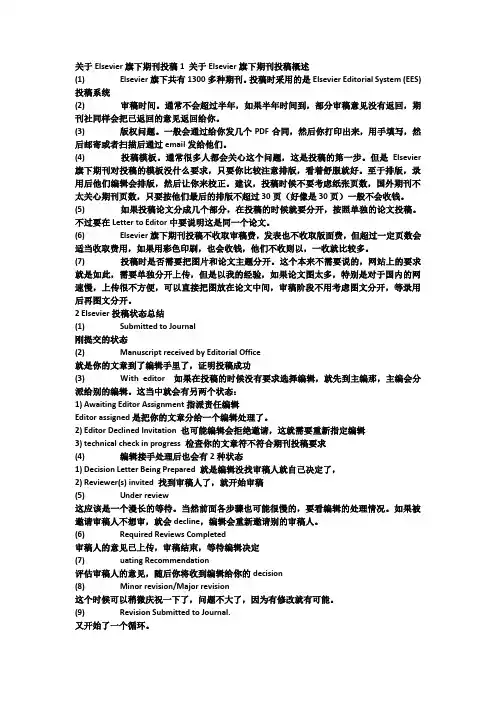
关于Elsevier旗下期刊投稿1 关于Elsevier旗下期刊投稿概述(1) Elsevier旗下共有1300多种期刊。
投稿时采用的是Elsevier Editorial System (EES)投稿系统(2) 审稿时间。
通常不会超过半年,如果半年时间到,部分审稿意见没有返回,期刊社同样会把已返回的意见返回给你。
(3) 版权问题。
一般会通过给你发几个PDF合同,然后你打印出来,用手填写,然后邮寄或者扫描后通过email发给他们。
(4) 投稿模板。
通常很多人都会关心这个问题,这是投稿的第一步。
但是Elsevier 旗下期刊对投稿的模板没什么要求,只要你比较注意排版,看着舒服就好。
至于排版,录用后他们编辑会排版,然后让你来校正。
建议,投稿时候不要考虑纸张页数,国外期刊不太关心期刊页数,只要按他们最后的排版不超过30页(好像是30页)一般不会收钱。
(5) 如果投稿论文分成几个部分,在投稿的时候就要分开,按照单独的论文投稿。
不过要在Letter to Editor中要说明这是同一个论文。
(6) Elsevier旗下期刊投稿不收取审稿费,发表也不收取版面费,但超过一定页数会适当收取费用,如果用彩色印刷,也会收钱,他们不收则以,一收就比较多。
(7) 投稿时是否需要把图片和论文主题分开。
这个本来不需要说的,网站上的要求就是如此,需要单独分开上传,但是以我的经验,如果论文图太多,特别是对于国内的网速慢,上传很不方便,可以直接把图放在论文中间,审稿阶段不用考虑图文分开,等录用后再图文分开。
2 Elsevier投稿状态总结(1) Submitted to Journal刚提交的状态(2) Manuscript received by Editorial Office就是你的文章到了编辑手里了,证明投稿成功(3) With editor如果在投稿的时候没有要求选择编辑,就先到主编那,主编会分派给别的编辑。
这当中就会有另两个状态:1) Awaiting Editor Assignment指派责任编辑Editor assigned是把你的文章分给一个编辑处理了。
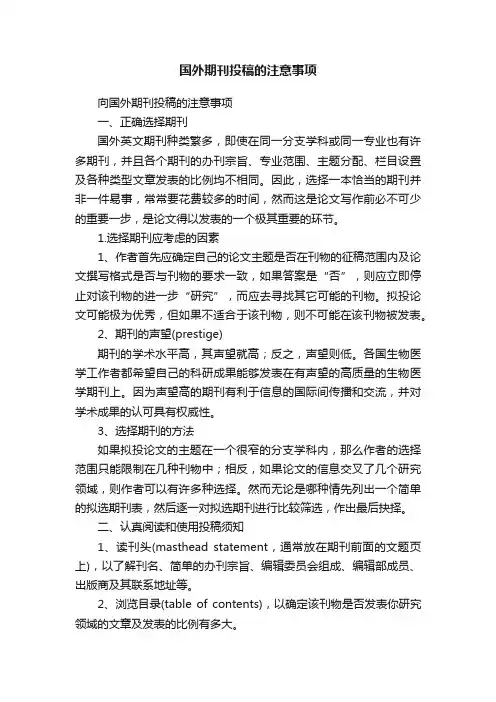
国外期刊投稿的注意事项向国外期刊投稿的注意事项一、正确选择期刊国外英文期刊种类繁多,即使在同一分支学科或同一专业也有许多期刊,并且各个期刊的办刊宗旨、专业范围、主题分配、栏目设置及各种类型文章发表的比例均不相同。
因此,选择一本恰当的期刊并非一件易事,常常要花费较多的时间,然而这是论文写作前必不可少的重要一步,是论文得以发表的一个极其重要的环节。
1.选择期刊应考虑的因素1、作者首先应确定自己的论文主题是否在刊物的征稿范围内及论文撰写格式是否与刊物的要求一致,如果答案是“否”,则应立即停止对该刊物的进一步“研究”,而应去寻找其它可能的刊物。
拟投论文可能极为优秀,但如果不适合于该刊物,则不可能在该刊物被发表。
2、期刊的声望(prestige)期刊的学术水平高,其声望就高;反之,声望则低。
各国生物医学工作者都希望自己的科研成果能够发表在有声望的高质量的生物医学期刊上。
因为声望高的期刊有利于信息的国际间传播和交流,并对学术成果的认可具有权威性。
3、选择期刊的方法如果拟投论文的主题在一个很窄的分支学科内,那么作者的选择范围只能限制在几种刊物中;相反,如果论文的信息交叉了几个研究领域,则作者可以有许多种选择。
然而无论是哪种情先列出一个简单的拟选期刊表,然后逐一对拟选期刊进行比较筛选,作出最后抉择。
二、认真阅读和使用投稿须知1、读刊头(masthead statement,通常放在期刊前面的文题页上),以了解刊名、简单的办刊宗旨、编辑委员会组成、编辑部成员、出版商及其联系地址等。
2、浏览目录(table of contents),以确定该刊物是否发表你研究领域的文章及发表的比例有多大。
3、注意栏目设置,确定拟投稿件的栏目。
4、看拟投栏目文章的范例,了解撰写要求及格式。
5、某些期刊刊登文章的投稿和接收日期(submitted and accepted dates),作者可据此计算出论文出版时滞(发表周期)。
6、注意广告数量,以间接判断期刊质量。
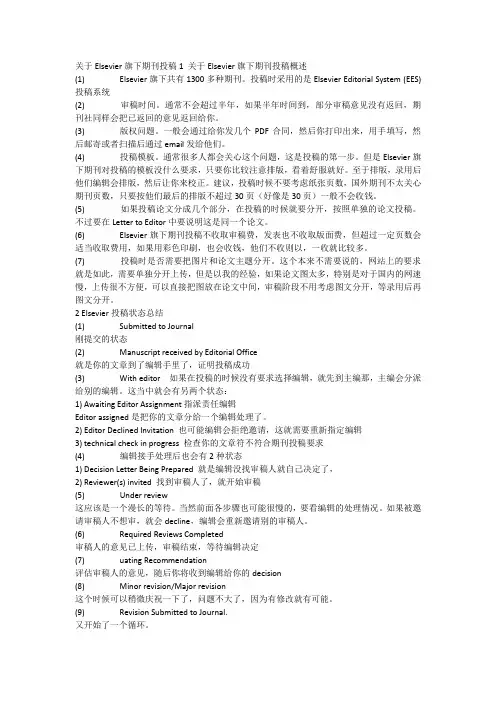
关于Elsevier旗下期刊投稿1 关于Elsevier旗下期刊投稿概述(1) Elsevier旗下共有1300多种期刊。
投稿时采用的是Elsevier Editorial System (EES)投稿系统(2) 审稿时间。
通常不会超过半年,如果半年时间到,部分审稿意见没有返回,期刊社同样会把已返回的意见返回给你。
(3) 版权问题。
一般会通过给你发几个PDF合同,然后你打印出来,用手填写,然后邮寄或者扫描后通过email发给他们。
(4) 投稿模板。
通常很多人都会关心这个问题,这是投稿的第一步。
但是Elsevier旗下期刊对投稿的模板没什么要求,只要你比较注意排版,看着舒服就好。
至于排版,录用后他们编辑会排版,然后让你来校正。
建议,投稿时候不要考虑纸张页数,国外期刊不太关心期刊页数,只要按他们最后的排版不超过30页(好像是30页)一般不会收钱。
(5) 如果投稿论文分成几个部分,在投稿的时候就要分开,按照单独的论文投稿。
不过要在Letter to Editor中要说明这是同一个论文。
(6) Elsevier旗下期刊投稿不收取审稿费,发表也不收取版面费,但超过一定页数会适当收取费用,如果用彩色印刷,也会收钱,他们不收则以,一收就比较多。
(7) 投稿时是否需要把图片和论文主题分开。
这个本来不需要说的,网站上的要求就是如此,需要单独分开上传,但是以我的经验,如果论文图太多,特别是对于国内的网速慢,上传很不方便,可以直接把图放在论文中间,审稿阶段不用考虑图文分开,等录用后再图文分开。
2 Elsevier投稿状态总结(1) Submitted to Journal刚提交的状态(2) Manuscript received by Editorial Office就是你的文章到了编辑手里了,证明投稿成功(3) With editor如果在投稿的时候没有要求选择编辑,就先到主编那,主编会分派给别的编辑。
这当中就会有另两个状态:1) Awaiting Editor Assignment指派责任编辑Editor assigned是把你的文章分给一个编辑处理了。
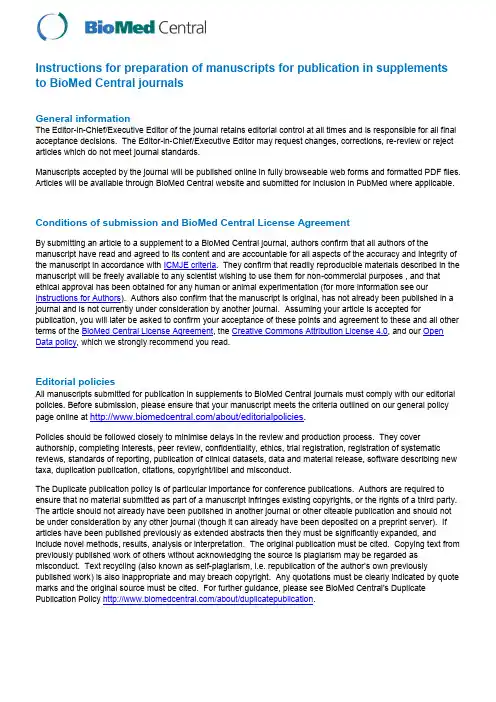
Instructions for preparation of manuscripts for publication in supplementsto BioMed Central journalsGeneral informationThe Editor-in-Chief/Executive Editor of the journal retains editorial control at all times and is responsible for all final acceptance decisions. The Editor-in-Chief/Executive Editor may request changes, corrections, re-review or reject articles which do not meet journal standards.Manuscripts accepted by the journal will be published online in fully browseable web forms and formatted PDF files. Articles will be available through BioMed Central website and submitted for inclusion in PubMed where applicable. Conditions of submission and BioMed Central License AgreementBy submitting an article to a supplement to a BioMed Central journal, authors confirm that all authors of the manuscript have read and agreed to its content and are accountable for all aspects of the accuracy and integrity of the manuscript in accordance with ICMJE criteria. They confirm that readily reproducible materials described in the manuscript will be freely available to any scientist wishing to use them for non-commercial purposes , and that ethical approval has been obtained for any human or animal experimentation (for more information see our Instructions for Authors). Authors also confirm that the manuscript is original, has not already been published in a journal and is not currently under consideration by another journal. Assuming your article is accepted for publication, you will later be asked to confirm your acceptance of these points and agreement to these and all other terms of the BioMed Central License Agreement, the Creative Commons Attribution License 4.0, and our Open Data policy, which we strongly recommend you read.Editorial policiesAll manuscripts submitted for publication in supplements to BioMed Central journals must comply with our editorial policies. Before submission, please ensure that your manuscript meets the criteria outlined on our general policy page online at /about/editorialpolicies.Policies should be followed closely to minimise delays in the review and production process. They cover authorship, completing interests, peer review, confidentiality, ethics, trial registration, registration of systematic reviews, standards of reporting, publication of clinical datasets, data and material release, software describing new taxa, duplication publication, citations, copyright/libel and misconduct.The Duplicate publication policy is of particular importance for conference publications. Authors are required to ensure that no material submitted as part of a manuscript infringes existing copyrights, or the rights of a third party. The article should not already have been published in another journal or other citeable publication and should not be under consideration by any other journal (though it can already have been deposited on a preprint server). If articles have been published previously as extended abstracts then they must be significantly expanded, and include novel methods, results, analysis or interpretation. The original publication must be cited. Copying text from previously published work of others without acknowledging the source is plagiarism may be regarded as misconduct. Text recycling (also known as self-plagiarism, i.e. republication of the author’s own previously published work) is also inappropriate and may breach copyright. Any quotations must be clearly indicated by quote marks and the original source must be cited. For further guidance, please see BioMed Central's Duplicate Publication Policy /about/duplicatepublication.Instructions for authors – articles for submission to supplementsPlease prepare your manuscript in accordance with the instructions for the relevant article type on the journal's website /authors/instructions. For BMC Proceedings, please follow the instructions for BMC Bioinformatics (/bmcbioinformatics/authors/instructions#submitManuscript) for biology-based supplements or BMC Medical Genetics(/bmcmedgenet/authors/instructions#submitManuscript) for medicine-based supplements.Important exceptions to the instructions for articles to be submitted to supplements are outlined below: SubmissionPlease do not submit your supplement manuscript via our online submission system unless specifically asked to do so. Manuscripts (in English) and figures for supplements should be submitted to the supplement organizers and will then be submitted by email or via our ftp site to BioMed Central.PaymentStandard article processing charges (APCs) do not apply for supplements. Publication fees do apply, and arrangements for payment are made outside the online APC payment system. Please contact the Supplements Office if you have any questions regarding fees or payment. Please note that we cannot process supplement payments via membership schemes and cannot apply waivers to supplements.DeclarationsIn addition to the online guidance, all supplement articles must include a Declarations section stating specifically the source of funding for the article’s publication fee. If an arrangement has been made for an organization to pay publication fees on behalf of authors, BioMed Central will add this statement. Where authors are arranging to pay a fee directly to BioMed Central, they make their own declaration in this section and this is usually in the form "Publication charges for this article have been funded by…"Competing interestsAll articles should include a Competing interests section. It is particularly important for sponsored supplements to include relevant disclosures and to include a statement regarding any named sponsor products or compounds in development referred to in the article.ProofsThe supplement organizer will send links to the online proofs and corrections should be returned by email. Once the full text version of the article is finalised, we will create the PDF versions and check these in-house. Corrections cannot be made after the online proof stage.Author presubmission checklist for manuscripts for publication in supplements to BioMed Central journalsBefore submitting the manuscript to your supplement organizer, please go through the list of points below, and refer back to the main instructions if necessary. You should be aware that failure to follow the instructions may cause interruptions to the review and production process which could result in delayed publication of the whole supplement. If it is necessary to make any changes in proof due to incorrect formatting of the original files, changes will be at the discretion of the EditorsWhen you have checked each of the points, please make the required changes to your files.Incorrectly formatted manuscripts cause problems and delays during the production process.Title page of manuscript1. Authors' affiliations should be in the following format: Department, Institute, City, Post/Zip code, Country.2. Each affiliation must be linked to an author.3. All authors must be linked to their corresponding affiliation(s) using superscript numerals.4. Authors should not list their qualifications on the title page.5. One corresponding author should be indicated.6. A contact email address must be listed for each author.7. The title should be in bold, sentence case with no full stop at the end and no underlining.Manuscript sections8. Abstracts should be no longer than 350 words.9. Abstracts should not cite references, figures or tables, and the use of abbreviations should be minimized.10. The abstract should include trial registration details, if appropriate.11. All articles should include the following sections (in order): Abstract; Background; Main text with appropriate subheadings (see onlineinstructions for authors - for research articles headings should include Methods, Results, Discussion, Conclusions); List of abbreviations used (if any); Competing interests; Ethics and consent; Declarations; Acknowledgements; References; Figure legends (if any); Tables (if any); Additional data files (if any). Do not number the sections.12. Please use sentence case for titles, headings and subheadings, with no unnecessary initial capital letters.13. Figures must be supplied as separate files (see below).14.Do not include footnotes or text boxes.15.Avoid including long URLs in the main body of the text, put them in the reference section with the name of the website.16. A competing interests section must be included17. A declarations section must be included18. Ensure that permission has been obtained to reproduce any previously published materials (e.g. text sections, reproduced figures/tables, etc”) and make sure the original publications are correctly referencedReferences19. References must be cited in the text using consecutive numbers in square brackets.20. References to other articles from within the same Supplement as your article must be highlighted in red.21. The reference list should be provided in the correct format so that the links to each referenced article’s abstract onPubMed (and/or the full text on the publisher’s website if applicable) can be created.Figures22.Each figure must be provided as a separate file, not embedded in the main manuscript file.23. If a figure consists of separate parts e.g. A and B, it is important that these parts are submitted in a single figure file andnot as individual figure files.24. The image file should not include the figure number, title or legend; these should be included in the manuscript file afterthe references. Sub-labelling (e.g. A, B, C) may be included in the figure file.25. Figures must be closely cropped so that only a small white border appears around the image.26. Figures should be of adequate resolution to ensure good reproduction online.27. Please name figure files so it is easy to identify which manuscript they belong to and which figure number they are.28. Indicate clearly if a figure is being reproduced or adapted with permission from another publicationTables29. Tables smaller than one side of A4 (210mm x 297mm) can appear within the main article and should be included at theend of the manuscript file, in the order that they are referred to in the text.30. Tables must be divided into cells/fields - tables generated with tabbed text are not acceptable.31. Tables should not include colour or shadingAdditional files32. These may consist of larger tables or other files, such as movies, PDF files, etc, that are not intended to appear withinthe body of the article.33. If authors have included additional files, they must include a separate section in the manuscript that lists: file name(s),file format(s), title(s) of data and short description(s) of data.34. Additional files must have the appropriate three-letter file extension for the programme you have used to generate them (e.g. .xls forExcel; .pdf for Acrobat files etc). Additional files must be cited in the text in the following way, eg: "see Additional file 1".。
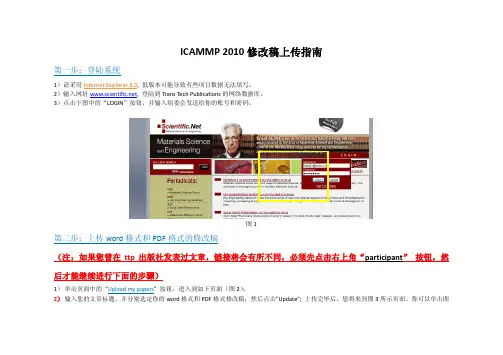
ICAMMP 2010修改稿上传指南第一步:登陆系统1)请采用Internet Explorer 8.0, 低版本可能导致有些项目数据无法填写。
2)输入网址, 登陆到Trans Tech Publications的网络数据库。
3)点击下图中的“LOGIN”按钮,并输入组委会发送给你的账号和密码。
图1第二步:上传word格式和PDF格式的修改稿(注:如果您曾在ttp出版社发表过文章,链接将会有所不同,必须先点击右上角“participant”按钮,然后才能继续进行下面的步骤)1)单击页面中的”Upload my papers”按钮,进入到如下页面(图2);2)输入您的文章标题,并分别选定你的word格式和PDF格式修改稿;然后点击”Update”; 上传完毕后,您将来到图3所示页面。
你可以单击图3中word文档和PFD文档链接;检查是否能正常打开,并确保PDF文件中论文的全部内容都位于红线框内(图4)。
请注意,如果你的内容位于红线框外,则可能你的word页面边距设置错误。
务必重新修改后上传。
图2图3图4请注意,论文内容不能位于红线框外第三步:签署并上传版权转让协议1)点击链接,下载版权协议书,全部作者签名后,扫描成图片文件或者PDF文件后并上传。
注意:要求论文中的每一位作者都要签署,签名中英文或手写图画均可,下图为示例。
上传后,你可以点击此处链接查看。
图5 全部作者都需要签名第四步:填写全部作者联系信息1)按作者在文中署名次序先后,填写全部作者的联系信息。
点击”Add author”链接, 填写作者姓名和邮件地址(图6),单击“Search”按钮,你将进入到图7所示界面,单击图中的”Set as Author”按钮;将来到图8所示作者信息录入页面,请务必详细填写下图中各项信息。
填写完毕后,单击update按钮。
请按上述方式,依次填写全部作者信息(请注意,不能留空,需全部填写,如不按要求填写,出版社不会接纳您的稿件!)。
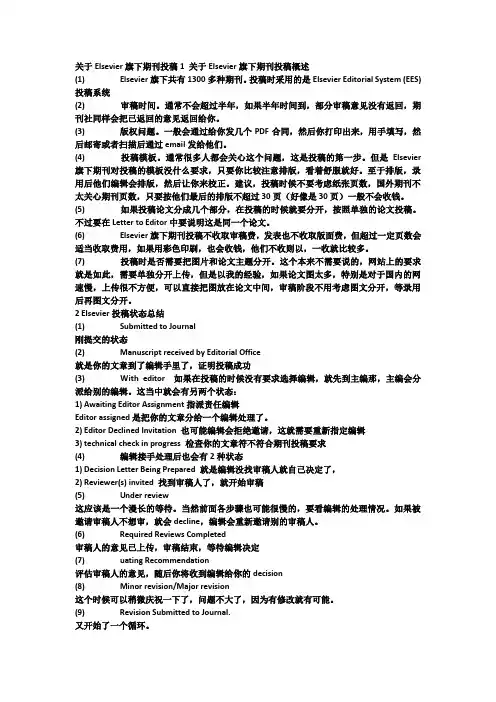
关于Elsevier旗下期刊投稿1 关于Elsevier旗下期刊投稿概述(1) Elsevier旗下共有1300多种期刊。
投稿时采用的是Elsevier Editorial System (EES)投稿系统(2) 审稿时间。
通常不会超过半年,如果半年时间到,部分审稿意见没有返回,期刊社同样会把已返回的意见返回给你。
(3) 版权问题。
一般会通过给你发几个PDF合同,然后你打印出来,用手填写,然后邮寄或者扫描后通过email发给他们。
(4) 投稿模板。
通常很多人都会关心这个问题,这是投稿的第一步。
但是Elsevier 旗下期刊对投稿的模板没什么要求,只要你比较注意排版,看着舒服就好。
至于排版,录用后他们编辑会排版,然后让你来校正。
建议,投稿时候不要考虑纸张页数,国外期刊不太关心期刊页数,只要按他们最后的排版不超过30页(好像是30页)一般不会收钱。
(5) 如果投稿论文分成几个部分,在投稿的时候就要分开,按照单独的论文投稿。
不过要在Letter to Editor中要说明这是同一个论文。
(6) Elsevier旗下期刊投稿不收取审稿费,发表也不收取版面费,但超过一定页数会适当收取费用,如果用彩色印刷,也会收钱,他们不收则以,一收就比较多。
(7) 投稿时是否需要把图片和论文主题分开。
这个本来不需要说的,网站上的要求就是如此,需要单独分开上传,但是以我的经验,如果论文图太多,特别是对于国内的网速慢,上传很不方便,可以直接把图放在论文中间,审稿阶段不用考虑图文分开,等录用后再图文分开。
2 Elsevier投稿状态总结(1) Submitted to Journal刚提交的状态(2) Manuscript received by Editorial Office就是你的文章到了编辑手里了,证明投稿成功(3) With editor如果在投稿的时候没有要求选择编辑,就先到主编那,主编会分派给别的编辑。
这当中就会有另两个状态:1) Awaiting Editor Assignment指派责任编辑Editor assigned是把你的文章分给一个编辑处理了。
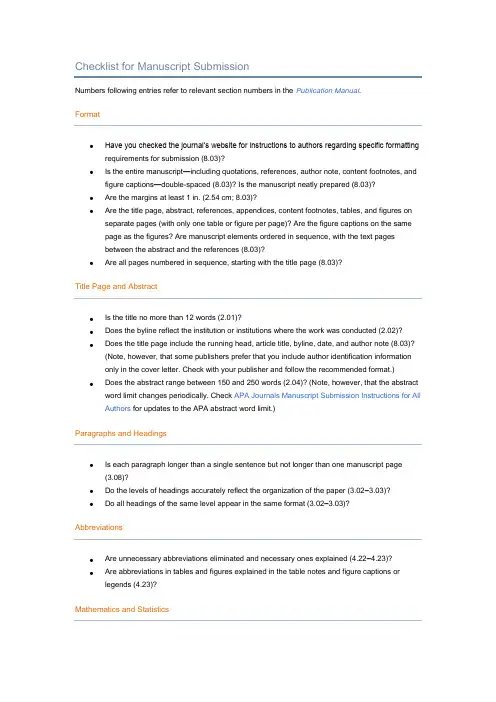
Checklist for Manuscript SubmissionNumbers following entries refer to relevant section numbers in the Publication Manual.Format•Have you checked the journal’s website for instructions to authors regarding specific formatting requirements for submission (8.03)?•Is the entire manuscript—including quotations, references, author note, content footnotes, and figure captions—double-spaced (8.03)? Is the manuscript neatly prepared (8.03)?•Are the margins at least 1 in. (2.54 cm; 8.03)?•Are the title page, abstract, references, appendices, content footnotes, tables, and figures on separate pages (with only one table or figure per page)? Are the figure captions on the samepage as the figures? Are manuscript elements ordered in sequence, with the text pagesbetween the abstract and the references (8.03)?•Are all pages numbered in sequence, starting with the title page (8.03)?Title Page and Abstract•Is the title no more than 12 words (2.01)?•Does the byline reflect the institution or institutions where the work was conducted (2.02)?•Does the title page include the running head, article title, byline, date, and author note (8.03)?(Note, however, that some publishers prefer that you include author identification informationonly in the cover letter. Check with your publisher and follow the recommended format.) •Does the abstract range between 150 and 250 words (2.04)? (Note, however, that the abstract word limit changes periodically. Check APA Journals Manuscript Submission Instructions for All Authors for updates to the APA abstract word limit.)Paragraphs and Headings•Is each paragraph longer than a single sentence but not longer than one manuscript page(3.08)?•Do the levels of headings accurately reflect the organization of the paper (3.02–3.03)?•Do all headings of the same level appear in the same format (3.02–3.03)?Abbreviations•Are unnecessary abbreviations eliminated and necessary ones explained (4.22–4.23)?•Are abbreviations in tables and figures explained in the table notes and figure captions or legends (4.23)?Mathematics and Statistics•Are Greek letters and all but the most common mathematical symbols identified on the manuscript (4.45, 4.49)?•Are all non-Greek letters that are used as statistical symbols for algebraic variables in italics(4.45)?Units of Measurement•Are metric equivalents for all nonmetric units provided (except measurements of time, which have no metric equivalents; see 4.39)?•Are all metric and nonmetric units with numeric values (except some measurements of time) abbreviated (4.27, 4.40)?References•Are references cited both in text and in the reference list (6.11–6.21)?•Do the text citations and reference list entries agree both in spelling and in date (6.11–6.21)?•Are journal titles in the reference list spelled out fully (6.29)?•Are the references (both in the parenthetical text citations and in the reference list) ordered alphabetically by the authors’ surnames (6.16, 6.25)?•Are inclusive page numbers for all articles or chapters in books provided in the reference list(7.01, 7.02)?•Are references to studies included in your meta-analysis preceded by an asterisk (6.26)? Notes and Footnotes•Is the departmental affiliation given for each author in the author note (2.03)?•Does the author note include both the author’s current affiliation if it is different from the bylin e affiliation and a current address for correspondence (2.03)?•Does the author note disclose special circumstances about the article (portions presented at a meeting, student paper as basis for the article, report of a longitudinal study, relationship thatmay be perceived as a conflict of interest; 2.03)?•In the text, are all footnotes indicated, and are footnote numbers correctly located (2.12)? Tables and Figures•Does every table column, including the stub column, have a heading (5.13, 5.19)?•Have all vertical table rules been omitted (5.19)?•Are all tables referred to in text (5.19)?•Are the elements in the figures large enough to remain legible after the figure has been reduced to the width of a journal column or page (5.22, 5.25)?•Is lettering in a figure no smaller than 8 points and no larger than 14 points (5.25)?•Are the figures being submitted in a file format acceptable to the publisher (5.30)?•Has the figure been prepared at a resolution sufficient to produce a high-quality image (5.25)?•Are all figures numbered consecutively with Arabic numerals (5.30)?•Are all figures and tables mentioned in the text and numbered in the order in which they are mentioned (5.05)?Copyright and Quotations•Is written permission to use previously published text; test; or portions of tests, tables, or figures enclosed with the manuscript (6.10)? See Permissions Alert (PDF: 16KB) for more information.•Are page or paragraph numbers provided in text for all quotations (6.03, 6.05)?Submitting the Manuscript•Is the journal editor’s contact information current (8.03)?•Is a cover letter included with the manuscript? Does the lettera. include the author’s postal address, e-mail address, telephone number, and faxnumber for future correspondence?b. state that the manuscript is original, not previously published, and not underconcurrent consideration elsewhere?c. inform the journal editor of the existence of any similar published manuscripts writtenby the author (8.03, Figure 8.1)?d. mention any supplemental material you are submitting for the online version of yourarticle?。
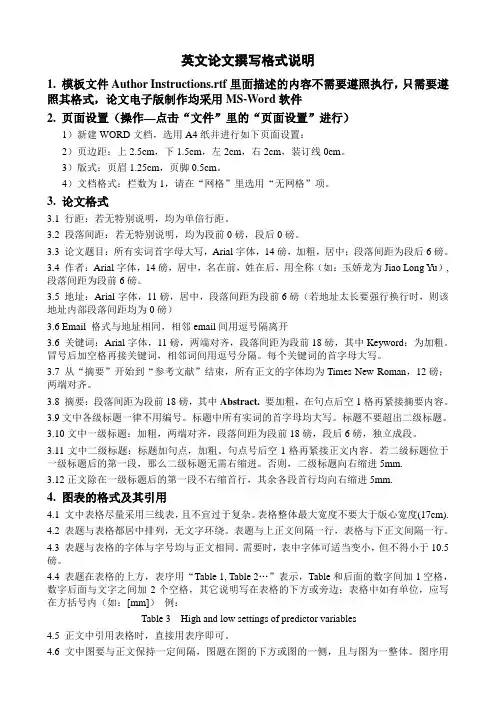
英文论文撰写格式说明1. 模板文件Author Instructions.rtf里面描述的内容不需要遵照执行,只需要遵照其格式,论文电子版制作均采用MS-Word软件2. 页面设置(操作—点击“文件”里的“页面设置”进行)1)新建WORD文档,选用A4纸并进行如下页面设置:2)页边距:上2.5cm,下1.5cm,左2cm,右2cm,装订线0cm。
3)版式:页眉1.25cm,页脚0.5cm。
4)文档格式:栏数为1,请在“网格”里选用“无网格”项。
3. 论文格式3.1 行距:若无特别说明,均为单倍行距。
3.2 段落间距:若无特别说明,均为段前0磅,段后0磅。
3.3 论文题目:所有实词首字母大写,Arial字体,14磅,加粗,居中;段落间距为段后6磅。
3.4 作者:Arial字体,14磅,居中,名在前,姓在后,用全称(如:玉娇龙为Jiao Long Yu), 段落间距为段前6磅。
3.5 地址:Arial字体,11磅,居中,段落间距为段前6磅(若地址太长要强行换行时,则该地址内部段落间距均为0磅)3.6 Email 格式与地址相同,相邻email间用逗号隔离开3.6 关键词:Arial字体,11磅,两端对齐,段落间距为段前18磅,其中Keyword:为加粗。
冒号后加空格再接关键词,相邻词间用逗号分隔。
每个关键词的首字母大写。
3.7 从“摘要”开始到“参考文献”结束,所有正文的字体均为Times New Roman,12磅;两端对齐。
3.8 摘要:段落间距为段前18磅,其中Abstract. 要加粗,在句点后空1格再紧接摘要内容。
3.9文中各级标题一律不用编号。
标题中所有实词的首字母均大写。
标题不要超出二级标题。
3.10文中一级标题:加粗,两端对齐,段落间距为段前18磅,段后6磅,独立成段。
3.11文中二级标题:标题加句点,加粗。
句点号后空1格再紧接正文内容。
若二级标题位于一级标题后的第一段,那么二级标题无需右缩进。
kretchmer@ • Journal Submission ChecklistSan Francisco EditIt is important to prepare your manuscript properly, part of which is to follow the journal’s guidelines. Using a checklist helps to ensure acceptance of your manuscript by the journal.Almost all journals have their guidelines on their website as well as publish their guidelines quarterly or in every issue. Guidelines are subject to change, so be sure you have the most recent guidelines. Below is a general checklist to assist you in ensuring your manuscript meets all the journal’s requirements. Every journal is different and not all journals will require all of the items listed. Depending upon the journal you are targeting, you might want to add specific items to this list.Cover LetterDetermine whether a cover letter is neededAddress the correct editor according to the manuscript subjectUse the correct addressReview what is required in the cover letterGeneralDetermine the article type you are submittingUse the correct font type and sizeAdjust the line spacing (single or double spacing)Check the format for section headingsPut the sections in the correct orderCheck the word length limitsUse line numbering, if requiredUse page numbers, if requiredAdjust the margin sizeConfirm that the nomenclature is correctCheck spellingDetermine whether the Results and Discussion are separate sections or included together in one sectionkretchmer@ • Title PageVerify the allowed Title lengthDetermine whether a running or short title is neededCheck whether Keywords are neededConfirm whether a List of Abbreviations is neededEnsure that all authors are listedMake sure the author’s names and address are in the correct formatInclude all corresponding author informationAbstractConfirm the word limitDetermine whether a structured or unstructured abstract is neededReferencesConfirm that the in-text citation format is correctVerify that all references cited in the text are included in the Reference ListMake sure that all references in the Reference List are cited in the textDetermine whether the references are formatted correctlyCheck the accuracy of the referencesTables and FiguresEnsure that the in-text mention of figures and tables is formatted correctlyDetermine whether the Tables and Figures are located in the correct locationVerify that the correct fonts and font size are used in the tables and figuresConfirm numbering format for tables and figures (Roman or Arabic)Ensure that the size of figures and tables are correctCheck that the correct file format is used (pdf, jpeg, gif, etc.)Determine the type of list for table titles and figure legendsMake sure that all tables and figures are mentioned in the textDetermine whether vertical lines are allowed in tablesOtherDetermine whether a conflict of interest statement is neededCheck to see whether funding sources are requiredFor medical manuscripts: Include an ethical and patient approval statementIf you need help in beginning to write your manuscript, please read our article Twelve Steps in Developing an Effective First Draft at /newsletters.htm.。
CARBON submission checklistPlease check the following points before approving the PDF file for your manuscript. Manuscripts that do not conform may be returned for correction and resubmission. You should be able to answer “yes” to all of the following questions. Items 11 and 14 may not be applicable.1. Is the manuscript double–spaced or 1.5-spaced with a font size of 12 pt.? (Times or Times New Roman and 1 inch margins are preferred)?Yes.2. Have you given full addresses and affiliations for all co–authors?Yes.3. Does the manuscript include a one paragraph abstract of less than 200 words (Review articles and Research papers) or less than 100 words (Letters)? Make sure the abstract is included in the manuscript. For the manuscript of a Letter separate the abstract from the text by an extra line space or a horizontal line.Yes.4. Is the corresponding author or corresponding authors identified by * and contact details (tel. number and e–mail address) given as a footnote to the first page? Do not include the address, which should be included in the ms heading as part of the author affiliations. Use the following format:*Correspondingauthor.E-mail:*********************(RobertHurt)Note: Carbon allows more than one corresponding author to be listed on the title page of the manuscript and published article. During submission, however, the electronic system will request a single corresponding author with whom we will communicate during the review purposes. We recommend this author be one of the senior members of the author team.Yes.5. Are sections given Arabic numbers with subsections numbered using the decimal system? For example:2. Experimental2.1 Sample preparation2.1.1 Sample modificationNOTE: Acknowledgements and References sections are not numbered.Yes.6. References.- are they each given a different number? (do not use 14a. b. c etc.)- do they all include manuscript titles and page spans?- have you given the first six author names followed by et al.?- are they archival? “Web pages, private communications, unpublished results,etc. should be given as footno tes.”Yes.7. Are all symbols translated correctly in the PDF file? Please double check equations. Yes.8. Have you designated all illustrative items as Figures? “Charts, diagrams, schemes and photographs are all to be referred to in CARBON as Figures".Yes.9. Please imbed figures, tables, and captions within the text after they are first introduced in the text and not at the beginning of a section. They do not need to be listed separately at the back of the manuscript.Yes.10. Have you included the carbon in abbreviations (CNT, CNF, MWCNT etc.)?NOTE: English grammar dictates that the abbreviation must refer to the singular. One does not use theplural noun as an adjective (fiber composites, fruit salad, nanotube dimensions, vegetable soup, etc.) One says “the production of MWCNTs”, but “MWCNT production”, “MWCNT properties”, etc.Yes.11. For a Letter to the Editor – is the text, including references, less than five double-spaced pages? Also, are there no more than five figures + tables combined?12. Have you provided a list of names, affiliations, and e-mail addresses for at least three suggested international (at least two countries) peer reviewers? Also have you included a short rationale for each suggested reviewer choice?Yes.13. Does your use of abbreviations conform to the following guidelines given in the Editorial in CARBON 44/5?1. To define an abbreviation, first write the term in full followed by the abbreviation in parentheses. “X-ray diffraction (XRD) examination showed that the samples were …..” Do not do the reverse.2. Never use or define an abbreviation in the manuscript title.3. Never use abbreviations in the Abstract without defining them, and only define them if they are usedlater in the Abstract.4. Define an abbreviation the first time it is used in the text, even though it may also have beennecessary to define it in the Abstract.5. Only define an abbreviation if you are going to use it later.Yes.14. If this is a resubmission as a result of comments from the Editor, have you included replies to these comments in your cover letter?。
General-Template[Title Page]Article TitleAuthorsAuthor affiliationsCorrespondence information: Corresponding author name,affiliation, detailed permanent address, email address,telephone number(Check the Guide for authors to see the required information onthe title page)Put the title of your abstract here using both upper and lower case letters, Times New Roman, 12?pts, bold, centered, doublespacedA.?Author a,B.?Author b,C.?Author a,*a Department, University, Street, Postal-Code City, Countryb Laboratory, Institute, Street, Postal-Code City, Country AbstractThis general template helps you on preparing manuscript for part of Elsevier Journals. Use this document as a template if you are using Microsoft Word 6.0 or later. Here comes self-contained abstract. Please read the Guide for Authors of your target journal for the requirements of Abstract. Pay special attention to the word count.PACS(optional, as per journal):Keywords:Keyword 1.D; Keyword 2.B (Read the Guide for Authors for the requirements for Keywords, including number, thesaurus, and classification indications)* Corresponding author. Tel.: +xx xxx xx xx; fax: +xx xxx xx xx.1. IntroductionThe manuscript should be prepared and submitted according to the Guide for Authors of your taget journal. . For your convenience, brief instructions on manuscript preparation are recorded below.Please DO consult a recent journal paper for style and conventions. You may find samples on ScienceDirect. You need to check your manuscript carefully before you submit it. The editor reserves the right to return manuscripts that do not conform to the instructions for manuscript preparation.2. General remarks on manuscript preparationGenerally, double line spacing, 12 pts font, and Times New Roman are preferred when you type the manuscript for review. This text formatting is provided in order to facilitate referee process and is also required for proper calculation of your manuscript length. Typing your manuscript follows the order: Title, Authors, Affiliations, Abstract, Keywords, Main text, Acknowledgements (optional), References (optional), Figure captions, Figures and Tables. Please consult the Guide for Authors for the proper organization of the main text. Ensure thateach new paragraph is clearly indicated. Some journals also require lines to be numbered throughout the manuscript. You will usually want to divide your article into numbered sections and subsections. Present figures and tables at the right places mentioned in the Guide for Authors.Most formatting codes are removed or replaced while processing your article so there is no need for you to use excessive layout styling. Please do not use options such as automatic word breaking, double columns or automatic paragraph numbering (especially for numbered references). Do use bold face, italic, subscripts, superscripts, etc., as appropriate.2.1 IllustrationsMany journals required that figures and tables to be presented on separate pages at the end of the manuscript. The preferable file formats are: EPS (for vector graphics) and TIF (for bitmaps). However, PDF and MS Office (Word, Excel, Powerpoint figures) files are also acceptable. Use file names that enable to identify their contents in terms of figure number and format (e.g. fig1.tif, fig2.eps, fig3.pdf). All artwork has to be numbered according to its sequence in the text. All of them should havecaptions. Colour figures in printed version require an extra fee for most journals. Generally, no vertical rules (lines) should be used in tables. Illustrations should not duplicate descriptions that appear elsewhere in the manuscript.Please look at for more detailed instructions on artwork preparations.2.2 EquationsConventionally, in mathematical equations variables and anything thatrepresents a value appear in italics. You are encouraged to use equation-editing tools such as mathtype to edit equations. Please make use of the numbering and referencing functions.2.3 CitationsThere are different styles of in-text citations and reference lists. DO consult the Guide for Authors to see the given examples. Pay special attention to the format of author names, journal names, publication year, volume and page span.AcknowledgementsThis section is optional.References[1].[2].Figure CaptionsFig.1 Put at this page the collected figure captions. The figure captions should be as brief as possible. It should also contain sufficient information that readers do not need to refer to the main text.Fig.2 Put here the figure caption of figure 2 (also the legend to figure 2).Fig. 3Fig.?1. Sample figure. Do not reduce or enlarge any images after placement in an MS Office application as this can lead to loss of image quality. While inserting vector graphics ensure that you use only truetype fonts. These should preferably be in one, or a combination, of the following fonts: Arial, Courier, Helvetica, Symbol, Times.Table?1Sample table: (使用三线表)Parameter Compound?1 Compound?2 a (?) 4.5832 4.9365Δ E a (eV) 1.745 1.592 ………………a This is an example of a table footnote.关于Elsevier旗下期刊投稿1 关于Elsevier旗下期刊投稿概述(1) Elsevier旗下共有1300多种期刊。
Sage Author's GuideforPreparing Your ManuscriptMANUSCRIPT CHECKLIST❏ Title❏ Subtitle❏ Table of Contents (matching hard copy and disk)❏ Camera-ready art❏ Original signed permissions (clipped together, labeled by chapter)❏ Disks (labeled, match hard copy)❏ References (at end of chapters or at end of book)❏ Primary contact person❏ Complete addresses for all authors (name, department, campus address, school or college, university, street address, city, state, zip code)❏ Complete contact information for all authors (telephone including extension if needed, fax, email address)❏ Author/editor bios❏ Contributor bios with confirmed spelling, middle initials❏ Acknowledgments❏ Foreword❏ Preface❏ Introduction❏ Marketing questionnaire(s)❏ Contracts, signed❏ TWO complete copies of the manuscriptOverview of the Production ProcessWhen the items on the Manuscript Checklist have been received by the acquisitions editor, your book will be transmitted to the production department and assigned to a production editor, who will work with you over several months to get the book to press.Acquisitions Editor: ________________________________________ Ext. ___________ Acquisitions Editorial Assistant: ______________________________ Ext. ___________The production editor coordinates the production process, from the time the book is received in production until it goes to press.Production Editor: _________________________________________ Ext. ___________ Production Assistant: ______________________________________ Ext. ___________The production process involves the following steps:♦ Production assistant organizes the book and contacts the author concerning any missing elements.♦ The production editor sends the book out for copyediting.♦ The copy editor contacts author(s) with any queries (e.g., information on references) and adds codes for typesetting. The book is then returned to the production editor, who reviews it and gives it to the typesetter/designer.♦ The typesetter designs the interior of the book (unless the book is in a series with a standard design) and sets the book.♦ The production editor sends proofs to a freelance proofer, to the author(s) and/or editor(s), and to the indexer.♦ The production editor reviews all corrections and collates them on one set of proofs.♦ The typesetter prepares a new set of proofs, which are checked by the production editor.♦ The production editor and another production staff member check and re-check the final pages to ensure that all the necessary corrections have been made.♦ The book is transferred to the Sage Manufacturing Department, and the book and its cover are sent to the printer.The acquisitions editor works with the Art and Marketing departments to design a cover.A promotion manager will work with you on marketing for your book.Promotion Manager: _________________________________________ Ext. _________Preparing Your Manuscript for SubmissionPreparing your manuscript according to these guidelines will help us make the production process a smooth one and keep the book on schedule. In the following pages, we have provided basic instructions for handling the various elements of your book, for preparing art, and for obtaining permissions. Instructions on formatting your manuscript can be found on pages 8-10. In addition, we have included sample pages to show how properly formatted manuscripts will appear (pp. 11-16).Organizing Your ManuscriptA manuscript may contain the following:♦ Title page♦ Table of Contents♦ Foreword♦ Preface♦ Introduction♦ Acknowledgments♦ Dedication♦ Text♦ Graphics: tables, figures, charts, graphics, photos, maps♦ Notes♦ References (works cited in text) with permissions as needed♦ Suggested readings or Bibliography (works not cited in text)♦ Appendix(es)♦ Glossary♦ Index♦ Biographies of author(s)Please begin your manuscript with a title page listing your full name, address, phone and fax numbers, and email addresses. At the top of each subsequent page, please type your name and the page number. Pages should be numbered sequentially from the beginning to the end of the entire manuscript. Please do not start each chapter with page 1.Double-space all material, including quotations, using one side only of white 8.5" by 11" paper. Allow sufficient margins on all sides; 1.5- or 2-inch margins are ideal. As your contract indicates, we need two hard copies of your manuscript. Please do not staple, clip, or bind the manuscript.TABLE OF CONTENTSPlease provide a detailed table of contents, listing not only chapters but also headings and subheadings within these chapters. We need this information to apply for a Library of Congress cataloguing listing for your book. This material will also be used in marketing.FOREWORDIf someone else has written a foreword, either an introduction to or a commentary about your book, it should be placed immediately after the table of contents and before the preface. A contract will be needed between Sage and the author of the foreword, so it is important to discuss any arrangements for a foreword with the acquisitions editor for your book prior to delivery of the final manuscript.PREFACE OR INTRODUCTIONSometimes the preface and the introduction are one and the same. If you have preliminary remarks about the volume, place them in a preface. The preface is an important selling tool and may contain a brief description of your goals, the intended audience, and distinctive features of the book. Detailed discussion of the purpose, intent, or scope of your work should be put in an introduction. Sage follows the guidelines in The Chicago Manual of Style, 14th Edition, with respect to numbering of introductory material:A relatively short introduction that is relevant to but not part of the text itself should bepaginated with the preliminaries, that is, with roman numerals. A long introduction or one that actually begins the subject matter of the text or that the author uses to set the scene -- to give, for example, the historical background of the subject -- should be part of the text, paginated with arabic numerals. (Section 1.52, p. 26)ACKNOWLEDGMENTSYou may wish to mention people who have contributed to your research or helped you with writing and publication. Acknowledgments can be a public thank-you to those who have made a difference: associates, staff, family, students, editors, or others.DEDICATIONA book's dedication is usually more personal than the acknowledgments. Here, you may choose to list parents, spouses, children, friends, or even entire groups of people to whom you wish to dedicate the book.GRAPHICSPlace each table, figure, graph, or other illustration on a separate page. Number these to correspond with the in-text reference to the graphic, and group all the illustrations for each chapter together at the end of the chapter. Show the in-text placement of graphics by inserting a call-out in the text of the manuscript:TABLE 1.1 ABOUT HEREorFIGURE 6.4 ABOUT HERENumbering Figures and TablesNumber figures and tables consecutively throughout each chapter. The first figure in Chapter 1 should be numbered Figure 1.1, the first figure in Chapter 2 should be 2.1, the second figure in Chapter 1 should be 1.2, and so forth. For example, the third table in the fourth chapter would be numbered Table 3.4. This numbering system allows the production staff to extract tables and figures from your manuscript for special typesetting codes while making sure that the correct graphics are placed where the call-outs indicate.Preparation of GraphicsKeep in mind that we will reduce the art to fit within the type area of the page. Typefaces, too, will be reduced, and type smaller than 8-point type like this will become too small to read. Also avoid type that is unusually large and type that is too heavy -- TYPE LIKE THIS.Screens and shading do not reproduce well; please avoid using them. To distinguish sections in a pie chart or bars in a graph, use black, white, and black-and-white patterns such as diagonal lines and dots. We will need hard copies of all art. If possible, please provide electronic versions of the art as well.Previously Published ArtIf you choose to use artwork that has been previously published, we prefer that you send the original art. If you cannot do so, send the cleanest, sharpest copy possible. If the art was previously published in a Sage book, we may or may not be able to retrieve the original for reproduction. Please check with us prior to sending your manuscript.Any table or figure directly reproduced requires permission. Tables or figures that have been adapted probably will not require permission but are subject to evaluation by Sage.Note: “Adapted” means that you have added your own material to the original work to extend or expand an idea, and not merely “edited” down or rearranged the work.Remember that if you do not own the rights to this art, you must first secure written permission to reprint it. This permission must be included when you send us your manuscript. Please see the instructions on permissions for additional information.PhotographsIf photographs are part of your manuscript, please send them as black-and-white glossy or matte positives. Color photos and transparencies do not reproduce well in black and white. Please do not trim the photo. Do not use paper clips with photos; the clip can leave an indentation on the photo that may reproduce on the printed page.Mark your photos on the back with a soft lead pencil, china-marking pencil, or soft felt-tip pen.A ballpoint pen or hard lead pencil may leave indentations. Avoid marking your photos or other art with Post-it notes that may come off.Using a Professional ArtistYou may choose to have a professional graphics designer prepare your art. Our acquisitions and production editors can recommend freelancers who do such work. Please share these instructions with any artist who will be preparing your work for Sage.When preparing art for us to reproduce exactly as you submit it, please consult the detailed instructions for camera-ready art available from your acquisitions editor and on the Sage Web site.Detailed instructions for preparing and submitting camera-ready are also available from the Art Department at Sage.If you are the editor of a volume, please make sure that contributors have these instructions for preparing graphics.NOTESIf you use footnotes, collect them as endnotes and insert them at the end of each chapter. REFERENCESThorough reference documentation provides readers with resources that enhance their understanding. If, within your text, you refer to a specific study or publication, be sure to provide complete bibliographic information in your reference section. The entry in the reference section should include author, title, date of publication, page numbers, and (for journals) volume number. Be sure to include issue numbers for journals that repaginate with each new issue. It is also desirable to include page ranges for chapters in edited books. Both in-text citations and reference listings must be consistently formatted. Sage's preferred style is that of the American Psychological Association (APA), found in the Publication Manual of the AmericanPsychological Association (4th edition). In this style, references are given in the text rather than in numbered notes, with the author's name and the year of the publication in parentheses. The proper format for the reference list itself can be found in Appendix 3-A on pages 189-234 of the Manual. The following are examples of APA reference list entries:Journal article, two authors, journal paginated by issue:Klimoski, R., & Palmer. S. (1993). The ADA and the hiring process in organizations. Consulting Psychology Journal: Practice and Research, 45(2), 10-36.An entire book:Cone, J. D., & Foster, S. L. (1993). Dissertations and theses from start to finish: Psychology and related fields. Washington, DC: American Psychological Association.Article or chapter in an edited book, three editors:Callicut, J. W. (2000). Social and mental health. In J. Midgley, M. B. Tracy, & L. Livermore (Eds.), The handbook of social policy (pp. 257-276). Thousand Oaks, CA: Sage.Electronic citations and references:Information that you get from the Internet should be documented. For details, please see the APA Web site on electronic resources at/journals/webref.html or /~xli/reference/apa.htmlA number of Web sites offer general guidelines to APA style. Two good sources are/apa/apa_index.htm and/acad/psych/apa4b.htmPERMISSIONSCopyright law is complex and extends protection to all media: books and publications, audio and video recordings, software programs, broadcast and news media, films, CD-ROMs, the Internet, and artistic or creative works, published or unpublished. As author, you shoulder the responsibility to obtain all necessary permissions and to pay any associated fees. Securing permissions can be a lengthy and expensive endeavor. How, then, do you know whether permission is required?In determining "fair use," courts consider these four factors:1. The purpose and character of the use, including whether such use is of a commercial natureor nonprofit educational purposes2. The nature of the copyrighted work3. The amount and substantiality of the portion used in relation to the copyrighted work as awhole4. The effect of the use on the potential market for or value of the copyrighted workSage's general permissions policy is to require written permission from the original copyright holder to reprint or adapt the material listed here.Artistic or Creative WorksPaintings, sculpture, fiction, logos, mastheads, and famous faces or body parts (models) require permission in all cases. Exceptions may be made when the work is the main topic with significant analysis. Permission fees for these works tend to be high.BooksPermission is needed for the use of more than 500 cumulative words from any single full-length book. Fiction or poetry requires more careful consideration.As with any other copyrightable material, it is Sage's policy to require permission for use of Internet or Web materials unless a particular use can be qualified as fair use or public domain. InterviewsWhenever possible, obtain a release to publish. If you cannot secure a release, depending on the nature of the interview and whether you identify the participants, we may need to exclude or otherwise protect the identities of individuals or entities.Journal Articles or Anthology ChaptersUse of more than 300 cumulative words from any single journal article or chapter requires permission. If your book includes entire articles or chapters already published elsewhere, permission must be granted by the original copyright holder. Because it is frequently a condition that the chapter appear as it was published and not be altered in any way, your permission request should specify whether you intend to edit the work.Newspapers or MagazinesPermission is needed for the use of more than two or three sentences. Authors must couple this use with analysis. If you intend to use mastheads, photos within articles, captions, or logos, you must spell these out on your request for permission, as these rights may be held separately.PhotosIn addition to permission from the copyright holder, if the photo was taken in a private location or is of a professional model, its use may require the subject's signed release. Photos of minors require releases from the minors' parents or guardians.Poetry or LyricsAnything, even a few words or a phrase and especially when used for effect rather than analysis, requires permission. These fees tend to be high.SpeechesUnless the speech is a political or campaign speech, its use probably requires permission if it is fixed in a tangible form (written or recorded).Permissions ProcedurePlease send permissions to Sage along with your manuscript, keep a copy for your records, and include the corresponding chapter or manuscript page numbers. Upon request, Sage can provide you with more detailed information on what requires permission and how to obtain it, and we can supply you with the necessary forms. A copy of the standard request for permission is included at the end of this guide.GLOSSARYIf you use terms that are likely to be unfamiliar to your readers, you may find it unwieldy to define these terms within the text itself. A glossary offers the opportunity to provide a separate section of terms and their definitions. This feature may also set your book apart from the competition.INDEXIndexing your book usually increases its value to readers. If your book is to be indexed, your publishing contract will specify whether you are responsible for preparing the index or whether Sage will have it prepared by a professional indexer. The contract will also indicate whether you or Sage is responsible for the cost of professional indexing.Regardless of who prepares the index, you can facilitate the process by developing a list of key words that should appear in the index. Further information on index preparation is provided in a booklet of indexing instructions for Sage authors available from your acquisitions or production editor and can be accessed at [LINK to indexing instructions].BIOGRAPHICAL SKETCHAlong with your manuscript, please send us a brief biographical sketch of about 250 words. The sketch should begin with your current position and may contain titles, affiliations, the focus of professional pursuits, and other information you wish to share with your readers. For edited volumes, biographical information will also be needed for the contributors. Normally, the editor's bio will be 100 to 150 words and the contributor bios about 75 to 100 words. Sage does not include information about undergraduate degrees. If you include information about postgraduate degrees, please include it for all contributors.CONTACT INFORMATIONIf you are the editor or lead author of a volume, please provide a detailed list of all contributors and authors. Include their full names (with middle initials or middle names if these are to appear in the book), complete street addresses, telephone and fax numbers, and email addresses. Because Sage now sends the typeset contributor proofs electronically (as PDF files), it is crucial to provide email contact information.If you or any contributors will have alternate or temporary addresses during the text 10 months, please list these as well. Throughout the production of your book, staff will depend on this list to link them to the people who can answer questions or provide clarification. Without this crucial information, production can be significantly delayed.Formatting Your ManuscriptAfter your manuscript is transmitted to the production department at Sage, both a disk and hard copy will be given to the copy editor, who will check the accuracy of cites and references, read for sense, make corrections in spelling, punctuation, and grammar, and insert coding necessary for typesetting. In preparing the text files, keep in mind that for production purposes, a simple presentation is best. A few basic formatting features (bold, italics, capitalization) should be used to make clear what level each heading is, what material is quoted directly from another source, and where graphics and other special material (such as boxed text) should be placed. Using additional formatting features to enhance the presentation may actually hinder production. At the end of this Guide, we have provided a sample of pages as they should appear in the manuscript you submit.HEADS AND LISTSThe heading for this whole section, "Formatting Your Manuscript," is a main heading or Level 1 head. These should be centered and can be set in bold type. The head above the beginning of this paragraph, "Heads and Lists," is a Level 2 head and should be set in all caps, flush left.Subordinate HeadsThe heading above this paragraph, "Subordinate Heads," is a Level 3 head and is set with initial caps, flush left. A fourth head level is one that is run into the text like the heads below that discuss different types of lists ("Numbered Lists" and "Bulleted Lists"). They are normally italicized. Each word may be capped if the head is short; if it is a complete sentence or is very long, only the first word is usually capitalized.Two Kinds of ListsNumbered Lists. Use numbered lists to present information that is sequential. In APA style, however, present elements in a series within a paragraph or sentence with lowercase letters in parentheses:The participant's three choices were (a) working with one other participant, (b) working with a team, and (c) working alone.Bulleted Lists. Use bulleted lists with care. The bullets call attention to each item in the list and can be visually useful in breaking up text. It's important not to overdo the use of bullets, however; the text itself should always be more important than the numbers or bullets you use to organize material.EXTRACTSThe copy editor will determine whether direct quotations, or extracts, should be set as regular body text or indented and set as an extract. The general guideline is that quotations of 40 words or more should be indented. When your book is typeset, long extracts will be set single-spaced and may also be in somewhat smaller type than regular text. In preparing your manuscript, you may want to indent long quotations; however, please double-space all material, including extracts of any length.COMPUTER DISKSOur production staff can work with most word-processing programs, although we prefer that you submit your manuscript on disks in Microsoft Word or WordPerfect. In creating your files, please follow these guidelines:♦ Place each chapter in a separate file.♦ Make sure that the hard copy of your manuscript matches the files on disk. If you are the editor of a volume, make sure that the hard copy of the chapters you submit matches the disk supplied by the contributor or by you. Production can be seriously delayed if there arequestions concerning what constitutes the final version of the chapter.♦ Label your disk(s) with the following:1. Your name and, if different, the lead author's name2. The name of the book3. The name and version of the program you are using (e.g., MS Word 6.0 forWindows)4. The names of the files on the diskA SAMPLE CHAPTER: COVER PAGEWHAT WE WOULD LIKE YOUR MANUSCRIPT TO LOOK LIKESage Publications2455 Teller Rd.Thousand Oaks, CA 91320Main telephone at Sage: 805-499-0721Books Production Fax: 805-375-1735The following pages illustrate how to use spacing and formatting to prepare your manuscript for Sage. The goal is to communicate clearly what each element is.♦ Please use margins of about 1.5 inches on all sides, and do not justify the right margin.♦ Avoid complex formatting codes.♦ Double-space all material.♦ Be sure that the difference between head levels is visually indicated.VERY IMPORTANT: Please make sure that the same margins and typeface are used for your entire manuscript. Estimates of the book's length are based on the pages you submit, and variations in page format and type make it much more difficult to make accurate estimates. Instructions and notes on formatting are in brackets.[This Is a Chapter Title:] Convening[This Is a Chapter Subtitle:] How to Arrange a MeetingChris CarlsonNo pessimist ever discovered the secrets of the stars, or sailed to an uncharted land, or opened a new heaven to the human spirit. [An opening quote]Helen Keller [A Quote Source][Here is some sample text to illustrate how to prepare heads and lists.] When someone convenes a meeting, he or she typically finds an appropriate meeting space, invites people to attend, and perhaps drafts an agenda. In a consensus building process, however, which may involve multiple meetings over the course of weeks, months, or years, convening is a more complex task. In this context, convening typically involves 1. assessing a situation to determine whether or not a consensus-based approach is feasible;2. identifying and inviting participants to ensure that all key interests (i.e., stakeholders) are represented;3. locating the necessary resources to help convene, conduct, and support the process; and4. planning and organizing the process with participants, or working with a facilitator or mediator to do so.Notice that in this numbered list, there is internal punctuation and the items are not capped. Another way to present this material would be as follows:1. Assessing a situation2. Identifying and inviting participants3. Locating the necessary resources4. Planning and organizing the process[Your word-processing program may put an extra space after the elements in a numbered list. You don't need to worry about these details of formatting. The copy editor will insert special codes that will standardize spacing for numbered and bulleted lists. Notice that this paragraph was indented to indicate that a new section starts after the last element in the numbered list.]Roles: This Is a Level 1 HeadA number of different actors are involved in the convening stage, including sponsors, convenors, neutrals, stakeholders, and participants, and these are defined in the following [bulleted list]:♦ Sponsors are individuals or organizations that endorse and support a consensus building process, often by providing financial assistance.♦ The convenor is the person or organization that initiates a consensus building process and that carries out the convening steps (or oversees how they are carried out). Often, because of the complexity or contentiousness of a situation, or due to lack of trust or credibility, a convenor may decide to use a professional neutral to carry out the convening steps.♦ The neutral is the facilitator or mediator who works with the convenor and other participants during the convening stage.♦ The stakeholders are the key individuals, groups, and organizations that have an interest in the issue at hand. Participants are stakeholders who take part inconsensus-based negotiations. Often, particularly in processes involving publicissues, participants represent other individuals with similar interests and concerns.Here's Another H1: The Importance of Convening: Two ExamplesHow the convening steps are carried out, and who carries them out, can have an impact on whether or not a consensus process will be successful. The parties who serve as convenors--whether they are government agencies, private corporations, nonprofit organizations, or individuals--need to be viewed as credible and fair-minded, especially in those cases in which issues are contentious or parties are distrustful of each other. At the community level, consensus processes are often sponsored and convened by a local leader, an organization, or a steering committee made up of representatives of different groups. At the state and federal levels, government agencies or officials often serve as sponsors, and sometimes as convenors.A COMMUNITY COLLABORATION GETS OFF ON THE RIGHT FOOT: A LEVEL 2 HEAD[Notice that this head is flush left, roman, and all caps.] In the first example, a divisive conflict over logging practices and their impact on endangered species was under way in a rural community in southern Oregon. By the early 1990s, there had been numerous skirmishes between environmental interests and timber industry supporters over logging in the Applegate Valley. In 1992, the listing of the northern spotted owl on the federal endangered species list led to an injunction prohibiting logging on federal lands.FEDERAL AGENCY CONVENES A SIMILAR PROCESS THAT FAILS: ANOTHER LEVEL 2 HEADOur second example came about as a result of the Applegate experience. Word spread quickly about the success of the Applegate Partnership. Federal officials caught wind of Applegate's success, and Interior Secretary Bruce Babbitt dropped in on one of the partnership meetings. What he saw fit nicely into the administration's plans for。
manuscript的用法全文共四篇示例,供读者参考第一篇示例:手稿(manuscript)是指未出版的文学作品、学术论文或其他文本的原始版本。
手稿通常是作者亲自书写或打印的,其目的是供他人阅读、评论和评审。
手稿是创作过程中的重要阶段,在完成之后经过编辑、审校等一系列流程,最终才能成为一部完整的出版物。
手稿的用途多种多样,可以包括小说、散文、诗歌、戏剧、学术论文、科研报告、简报等。
在出版领域,手稿是作品最初的形式,作者会将其提交给各种出版社、期刊或报纸,经过编辑部的评审和修改后,最终定稿出版。
在学术领域,手稿是研究成果的呈现形式,研究人员通过提交手稿向同行展示自己的研究成果,获得评论和建议。
手稿也是学术评价的重要依据,研究人员的学术成就往往与其发表的手稿数量和质量直接相关。
手稿的撰写需要一定的技巧和规范。
作者应该明确作品的目的和受众,确定合适的写作风格和结构。
作者应该注意语言的表达和逻辑的连贯,避免错别字、语法错误和逻辑不清晰。
作者应该注重细节,如标点符号的使用、段落的划分、引用的格式等,保证手稿的整体质量和可读性。
在传统的出版过程中,手稿通常需要经过严格的审查和修改,包括编辑、审校、排版等环节。
编辑会对手稿的内容、结构、语言进行评审和修改,确保作品的质量和准确性。
审校则负责校对手稿中的错误,如拼写错误、标点错误、语法错误等。
排版将手稿转换成适合出版的版面格式,包括字体、字号、行距、页眉页脚等,以便于读者阅读和理解。
随着数字化技术的发展,传统的手稿出版模式正在发生变革。
越来越多的作品选择通过网络平台、自助出版、电子书等途径发布,减少了中间环节的耗时和成本。
数字化手稿在传播、传播速度、搜索和存档等方面也具有明显的优势。
数字化手稿也面临着一些挑战,如版权保护、质量把控、传统观念的转变等,需要进一步研究和完善。
手稿是作品的重要形式之一,是作者展现自己创作成果的途径,也是出版、传播、交流和传承知识的重要媒介。
i resubmit this manuscriptIf you want to resubmit a manuscript, you can follow the steps below: Check the status of the previous submission. You can contact the editor or reviewer to understand the progress of the review or whether there are any problems that need to be resolved first.Prepare the manuscript for resubmission. You need to revise and improve the manuscript based on the feedback of the reviewers and editors. You can also add new data or information to strengthen your argument and support.Write a cover letter for resubmission. The cover letter should include a brief introduction of the previous review and the changes made in response to the reviewers' comments. You should also state the reasons for resubmission and your response to the comments of the reviewers and editors.Submit the revised manuscript and cover letter to the journal or publisher for reconsideration. You can use the online submission system or email to submit your revised manuscript and cover letter. Make sure you provide all necessary files and information required by the journal or publisher.Wait for the journal or publisher's decision on reconsideration. The review process may take some time, so be patient and wait for thedecision. If there are any further comments or suggestions from the reviewers or editors, you should revise your manuscript again and resubmit it again.I hope these steps can help you successfully resubmit your manuscript.。